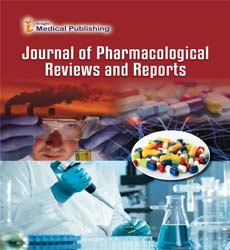Mechanism of Sulfacetamide in Conjunctivitis
Henrik Ottosson*
Department of Pharmacology, Lomonosov Moscow State University, Moscow, Russia
- *Corresponding Author:
- Henrik Ottosson
Department of Pharmacology
Lomonosov Moscow Satte University
Moscow, Russia
E-mail: ottossonhen@gmail.com
Received Date: October 5, 2021; Accepted Date: October 19, 2021; Published Date: October 26, 2021
Citation: Ottosson H (2021) Mechanism of Sulfacetamide in Conjunctivitis. J Pharmacol Rev Rep Vol.4 No.2:e002.
Abstract
The prognosis of acute infectious conjunctivitis may be tough. Clinical ambiguity exists among the intense viral and bacterial in addition to the allergic paperwork, which could confound prognosis. Also, discrimination among viral or bacterial origins of infectious conjunctivitis primarily based totally on historical, nonspecific, scientific symptoms and symptoms and signs and symptoms contributes to an excessive fee of misdiagnosis and overuse of antibiotic remedy. Therefore, with a purpose to efficiently deal with acute infectious conjunctivitis, physicians should be aware about the scientific symptoms and symptoms and signs and symptoms and to be had diagnostic assessments which can offer an extra correct differential prognosis.
Keywords
Allegic conjunctivitis; Bacerial conjunctivitis; Sulfacetamide; Sulphonamide; Para-aminobenzoic
Description
Conjunctivitis is a collective time period for a various institution of illnesses which might be characterized through infection of the conjunctiva. The maximum not unusual place motive of infectious conjunctivitis is viral contamination (~80% of instances), accompanied through bacterial. The noninfectious paperwork are allergic, mechanical/irritative/poisonous, immune-mediated, and neoplastic one of noninfectious conjunctivitis, the allergic shape is the maximum not unusual place, affecting about 40% of America population. Conjunctivitis also can be categorized as acute, persistent, or recurrent, consistent with the mode of onset and severity of the scientific response. Most instances of viral and bacterial conjunctivitis are taken into consideration acute and, much less frequently, as hyper acute. The mechanical/irritative/poisonous, immunemediated, and neoplastic paperwork are usually related to persistent infection, and the poisonous shape could have an acute onset. Allergic conjunctivitis may be persistent, with viable onset in childhood, and gift with acute exacerbations associated with seasonal elements or touch lens use, for example.
Challenges of acute infectious c onjun ctivitis management and diagnosis
Eye care specialists have a tendency to assess acute infectious conjunctivitis instances at secondary care visits. Patients with infectious conjunctivitis are sub optimally controlled in number one care because of an under appreciation of the superiority of viral conjunctivitis, in addition to common antibiotic prescriptions (80%) for infectious conjunctivitis, notwithstanding recommendations that discourage antibiotic use for minor selfrestricting illnesses. Antibiotic prescription is a degree of presumed prognosis of bacterial conjunctivitis, however the fee of scientific accuracy in diagnosing viral conjunctivitis can also additionally be <50%. Observational proof suggests that laboratory affirmation isolates bacterial pathogens in only 30– 50% of suspected instances.
To meet the American Academy of Ophthalmology Preferred Practice Pattern guidelines that treatment of conjunctivitis is directed at the cause, clinicians should treat cases ever, taking into account the epidemiologic stretch of Spreading conjunctivitis, history, clinical examination and Need symptomatic tests.
Clinical test
A premier Conjunctivitis is warranted to rule out any potentially serious cause of acute red eyes. True features for evaluation include pain or photophobia, which may be signs of bacterial keratitis, anterior uveitis, or acute angle- stoppage glaucoma. Associated symptoms, similar as an upper respiratory tract infection or known exposure to others who have had it, suggest a viral form of pink eye. A history of visual trauma should be considered as a possible obligatory cause of inflammation. Corneal scrape caused by a foreign object or exposure to the sun or ultraviolet light can appear as a red eye. Red, painful, and watery eyes caused by corneal or conjunctival foreign bodies can be disguised as acute and habitual forms of conjunctivitis. The presence of a foreign body is determined by medical history and careful biomicroscopic examination. Contact lens wearers are at high pitfall for corneal involvement and bacterial keratitis; so, these people must be pertained to an ophthalmologist.
Mechanism of action of sulfacetamide
Sulfacetamide is a sulfonamide antibiotic with bacteriostatic effects and broad spectrum activity against most gram-positive and many gram-negative organisms. However, many strains of a single species can be resistant. Sulfonamides inhibit the reproduction of bacteria by acting as competitive inhibitors of para-minobenzoic acid in the metabolic cycle of folic acid. Bacterial sensitivity is the same for the various sulfonamides, and resistance to one sulfonamide indicates resistance to all. Most sulfonamides are easily absorbed orally. However, parenteral administration is difficult because soluble sulfonamide salts are highly alkaline and irritating to tissues. Sulfonamides are widespread in all tissues. Elevated levels are reached in pleural, peritoneal, synovial, and ocular fluids. Although these drugs are no longer used to treat meningitis, CSF levels are high in meningeal infections. Its antibacterial effect is inhibited by pus.
Sulfacetamide is a competitive inhibitor of bacterial paraaminobenzoic acid (PABA), an essential component for bacterial growth (according to Woodsfield’s theory). The inhibited reaction is necessary for the synthesis of folic acid in these organisms.
Open Access Journals
- Aquaculture & Veterinary Science
- Chemistry & Chemical Sciences
- Clinical Sciences
- Engineering
- General Science
- Genetics & Molecular Biology
- Health Care & Nursing
- Immunology & Microbiology
- Materials Science
- Mathematics & Physics
- Medical Sciences
- Neurology & Psychiatry
- Oncology & Cancer Science
- Pharmaceutical Sciences
